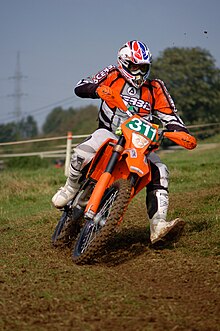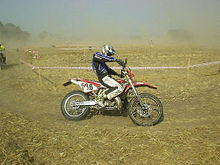Enduro sport
Enduro Sport (of English endurance is = endurance) international name for the motorcycle off-road racing . In enduro sports, it is not only speed that is decisive, but also the endurance and reliability of the motorcycle and the driver.
history
As early as 1903, the British Association of Motorcyclists organized a 1000-mile off-road trip, and from 1909 an annual off-road trip (“The Scottish Six Days Trial”) led through the Scottish highlands. From 1912 there was the "British six-day test for motorcycles". Test routes on roads with time and passage controls, terrain sections and hill climbs were built into the daily stages, which are around 270 km long. From 1913 were then under the direction of then-World Association FICM the first International Six Day trips , then still under the name International Six Days Trial , organized.
Despite the interruptions caused by the two world wars, the Six Days are the high point in enduro sports. The development and popularity of the Six Days is also groundbreaking for the development of enduro sports. Up until the 1960s, only slightly modified motorcycles were driven. With the introduction of special tests (including motocross), the specializations that were developing in motocross motorcycles were also adopted for enduro motorcycles . The motorcycles became more and more off-road due to longer suspension travel, greater ground clearance, high mudguards, and high exhaust systems. Following this development, the routes became more and more demanding. With the inclusion of steep ascents and descents as well as rocky passages, similar passages were also sought for the trial .
Due to environmental protection requirements and objections from property owners , there were many restrictions in Western Europe, especially in the Federal Republic of Germany . Many events were characterized by special tests in sand pits or similar cordoned-off terrain and then subsequent bridging trips on public roads. This development has led to a decline in interest in enduro sports in western Germany. There were no such restrictions in the GDR. After reunification, the organizers therefore endeavored to make the sporting events challenging despite the corresponding environmental protection requirements. The enduro race around Zschopau is exemplary . With the use of oil barriers , removal of damage after the race and integrated environmental management, attempts are made to reduce any negative impact on the environment.
Enduro is popular today in the Scandinavian countries ( Sweden , Finland ), as well as France , Italy , Great Britain and the United States . "Classic Offroad" with machines from the 1960s to 1980s is also very popular in many countries.
Until the crisis in motorcycle construction in the 1960s, most motorcycle manufacturers were represented in off-road sports. Later on, only a few manufacturers produced such motorcycles. The motorcycles from MZ , Jawa and Simson , which came from the countries of the Eastern Bloc , were not freely available for sale, but were generally only intended for the works teams. From Western Europe, the manufacturers Husqvarna , Maico , KTM , Puch , SWM and Zündapp have been successful competitors for many years. The Japanese manufacturers Yamaha , Honda and Suzuki have only been advancing into enduro racing since the 1990s . But new, specialized manufacturers of competitive enduro bikes , such as MotoTM , Husaberg and GasGas , were also able to gain a foothold in enduro sports.
Types of events
Enduro events are held in two different modes. In contrast to motocross, there is no mass start.
In the classic form of the enduro, a given course (a circuit of 50 to 80 km) usually has to be driven three to four times in a given time. If this time limit is not met, there will be penalties. In order to determine a clear winner, there are so-called special tests on a round. This can be motocross or extreme tests. The times achieved in this test are added up and then give the final result with the penalty times. The Enduro World Championship has started in the classes E1 (125 2T and 250 4T), E2 (250 2T and 450 4T) and E3 (300 2T and 500 4T) with a waiting time of one minute for three drivers since 2004 . Until then, the classes were up to 80 cm³, up to 125 cm³, up to 250 cm³, up to 500 cm³, up to 350 cm³ four-stroke and over 500 cm³ four-stroke. These classifications have been adapted over the years to the requirements or wishes of the manufacturer.
With an hour enduro ( Cross Country or Hare Scramble ) as many laps as possible must be completed on a circuit in a given time. Usually an adapted motocross track or a cordoned-off area is used for this. They usually last two, six or twelve hours.
In order to practice the enduro sport as an indoor sport or on a small limited area, the so-called enduro cross (EnduroX) was created as a variant . A Supercross- like route with corresponding terrain obstacles is prepared. When mastering these routes, skills from trial sports are sometimes required. The mode of competition also corresponds to the Supercross events.


